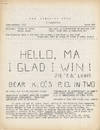![Leaf of Passionale in Latin [Italy, 12th century, first half]](https://d3525k1ryd2155.cloudfront.net/h/893/015/1378015893.0.m.jpg)
Leaf of Passionale in Latin [Italy, 12th century, first half]
by [St Felicity & St Clement]
- Used
- first
- Condition
- See description
- Seller
-
Castlethorpe, Buckinghamshire, United Kingdom
Payment Methods Accepted
About This Item
Physical description and Materiality
Parchment, a substantially complete leaf, c.260×375mm, but the corners trimmed to allow mitering and one margin cropped to reduce the width to the required size, ruled in dry-point on the hair-side for two columns of 36 lines written above top line in a fine regular rounded late Caroline bookhand, with a rubric in red and an enlarged initial in red divided into two panels, foliated "cxlvj" in the middle of the upper margin.
The shape of the book that this leaf covered is clearly preserved; the very darkened spine still has one of two paper labels preserved, inscribed with a shelfmark "[…] 5. b | 29", and rows of holes show where the cover was sewn to the boards. Unlike the vast majority of medieval manuscript leaves re-used as book covers (including those in this catalogue), the outer face is almost entirely blank: this cannot be due to fading or ordinary wear-and-tear, and shows that the binder have deliberately and carefully erased the text, probably with a pumice-stone or equivalent abrasive. He left the extreme outer corners legible, knowing that these turn-ins would be hidden when the book was closed (and might also be covered by pastedowns).
SCRIPT
This elegant, clear, rounded Italian bookhand is clearly related to those of nos. 3 and 5 above. The 'd' is usually upright, 'ę' is used for 'æ', round 's' is used only at the ends of words, double but not single 'i' is dotted, there is no kissing or fusing of adjacent rounded letters, and even double 'p' is well-spaced (e.g. "suppliciis", col. 1, line 7 from the bottom), 'f' usually descends below other minims, and 'r' sometimes does, but not tall 's', round 'r' appears after 'o'.
TEXT
Readings for the feast day of St Felicity and St Clement (both were venerated on 23 November):
"Respondit Vitalis Quis melius optat vivere … uiuit et regnat in secula seculorum. Amen. Incipit expositio Gregorii Tironensis ęcclesię liber miraculorum Clementis martiris. In diuinus uoluminibus refertur quod secretum regis abscondere bonum est … quam in scrutabilia sunt".
The Felicity text is printed in Acta Sanctorum: Iulii, III (Paris & Rome, 1868), pp. 12(E)–13(A), and Flavia Salvatori, Il Gruppo agiografico di Felicita e i sette figli, thesis available online (Rome, 2008/09), pp. 135–36; it is followed by the start of Gregory of Tours's Miracles of St Clement (printed by H.L. Gregory, Les livres des miracles et autres opuscules de Georges Florent Grégoire, évéque de Tours (Paris, 1857), pp. 407–08).
The few easily legible words on the other side do not seem to be a continuation of the more legible side, and thus the latter is probably the verso.
DECORATION
The six-line initial 'I' in red is very simple, but serves its purpose; it was executed by the scribe with a pen and ink, not an artist with brush and pigment, as shown by the very fine hairline stroke at the lower left, and the adjacent rubric which has the same colour and texture.
Readings from the lives of saints were part of the Divine Office at the hour of Matins on their feast-days. In the 12th century these texts were typically in separate volumes (as with the present leaf), but there is some ambiguity in the terminology used to describe such volumes: they are often called Martyrologies in modern publications, but this is misleading. Martyrologies (such as the famous one compiled by Usuard) contain only lists of saints for each day of the year, with minimal biographical information: this was read out daily in the chapter house of a monastery. Very different types of books were used for the reading of long narrative accounts of the lives and deaths of saints: according to medieval sources, the "Passionarius" (or Passionale) recorded the lives and deaths of martyrs, and the "Legendarius" (or Legendary) recorded the lives of saints who were not martyrs. These Divine Office readings were later incorporated into Breviaries.
Reviews
(Log in or Create an Account first!)
Details
- Bookseller
- Butler Rare Books
(GB)
- Bookseller's Inventory #
- 1276
- Title
- Leaf of Passionale in Latin [Italy, 12th century, first half]
- Author
- [St Felicity & St Clement]
- Book Condition
- Used
- Quantity Available
- 1
- Date Published
- 1125
- Weight
- 0.00 lbs
- Keywords
- manuscript, C12th, twelfth century, Bible, Carolingian, vellum, parchment, France, medieval, painting
- Bookseller catalogs
- Manuscripts;
- Size
- 260 x 375mm
Terms of Sale
Butler Rare Books
About the Seller
Butler Rare Books
About Butler Rare Books
Glossary
Some terminology that may be used in this description includes:
- Leaves
- Very generally, "leaves" refers to the pages of a book, as in the common phrase, "loose-leaf pages." A leaf is a single sheet...
- Verso
- The page bound on the left side of a book, opposite to the recto page.
- Inscribed
- When a book is described as being inscribed, it indicates that a short note written by the author or a previous owner has been...
- Fine
- A book in fine condition exhibits no flaws. A fine condition book closely approaches As New condition, but may lack the...
- Spine
- The outer portion of a book which covers the actual binding. The spine usually faces outward when a book is placed on a shelf....
![Leaf of Passionale in Latin [Italy, 12th century, first half]](https://d3525k1ryd2155.cloudfront.net/h/893/015/1378015893.0.s.jpg)
![Leaf of Passionale in Latin [Italy, 12th century, first half]](https://d3525k1ryd2155.cloudfront.net/h/893/015/1378015893.1.s.jpg)
![Leaf of Passionale in Latin [Italy, 12th century, first half]](https://d3525k1ryd2155.cloudfront.net/h/893/015/1378015893.2.s.jpg)


